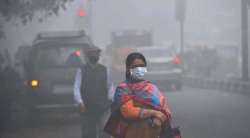Diwali pollution: Kolkata's air quality dips from moderate to poor on Kali Puja night
At 5 pm on Kali puja day (Thursday), the Air Quality Index (AQI) was 260 at Rabindra Bharati University (RBU) area, 171 at Ballygunje, 227 at Bidhannagar, 189 at Fort William, 229 at Jadavpur, 146 at Victoria Memorial and 148 at Rabindra Sarobar air monitoring station, WBPCB official said

Except for some pockets in south Kolkata very few cases of firecracker bursting were reported from the city on Kali Puja night even though the air quality in the metropolis dipped from moderate to poor, a West Bengal Pollution Control Board (WBPCB) official said on Friday. He said according to our knowledge except for some pockets in south Kolkata like Kasba, Jadavpur, Garia, Bansdroni and in areas like Kasipur, Dumdum, Sinthi, Baranagar and Chitpur there were very few incidents of fireworks bursting elsewhere and it was a quieter Kali Puja.
At 5 pm on Kali puja day (Thursday), the Air Quality Index (AQI) was 260 at Rabindra Bharati University (RBU) area, 171 at Ballygunje, 227 at Bidhannagar, 189 at Fort William, 229 at Jadavpur, 146 at Victoria Memorial and 148 at Rabindra Sarobar air monitoring station, he said. The official said in RBU area in north Kolkata the air quality turned worse as the AQI index read 315 (PM 2.5) at 9 am on Friday, after reaching 280 at 9 pm on Kali Puja day. In Jadavpur University area in south Kolkata the AQI remained at 246 at 9 am on Friday while it read 233 barely 12 hours back, while in Ballygunje area the AQI was 220 at 9 am on Friday from 182 just 12 hours back.
In Fort William area the AQI was 217, in Bidhannagar 207 and in Victoria area 203, in the morning after Kali puja night. The AQI was 192 in Fort William, in Bidhannagar 223, and in Victoria area 158 on the Kali puja night, the official said.
An AQI of 300-400 is termed as very poor in air quality parlance, it is defined as poor if it crosses 200 threshold and moderate if the AQI is between 101-200. The WBPCB official said due to wintry conditions in the air in this time of the year, particulate matters hang heavy in the air for hours. "The dip in air quality cannot be entirely attributed to the fireworks issue and more due to the moisture and the emissions from vehicular traffic as higher number of vehicles hit the road on the Kali puja night.
To our knowledge excepting pockets in south Kolkata like Kasba, Jadavpur, Garia, Bansdroni and in areas like Kasipur, Dumdum, Sinthi, Baranagar and Chitpur there were very few incidents of fireworks bursting elsewhere and it was a quieter Kalipuja," the WBPCB official said. Meanwhile, environmentalist Somendra Mohan Ghosh claimed that air quality didn't improve even after 12 hours on Friday as fireworks were burst in late evening hours.
Though the sounds of firecrackers were fewer than 2019, it was higher than last year in different pockets of the city and the intensity rose after 10 pm, Ghosh told PTI. Secretary of Sabuj Manch, Naba Dutta said "there was frequent bursting of crackers in different localities like 2019. It was higher than 2020. Apparently the ban on fireworks other green ones didn't work and banned crackers and shells entered into the city."
WBPCB records said while AQI was within 50 to 150 AQI across the city two weeks back and it hovered between 150 to 250 for past one week in the run up to Kali Puja. The Calcutta High Court on Wednesday directed that all necessary efforts must be made by the West Bengal government to ensure that only green crackers are used during Diwali-Kali Puja and other ensuing festivals, observing that the sincerity of the state would be reflected in enforcement mechanism.
READ MORE | Delhi air quality turns hazardous, crosses 600-mark at several places